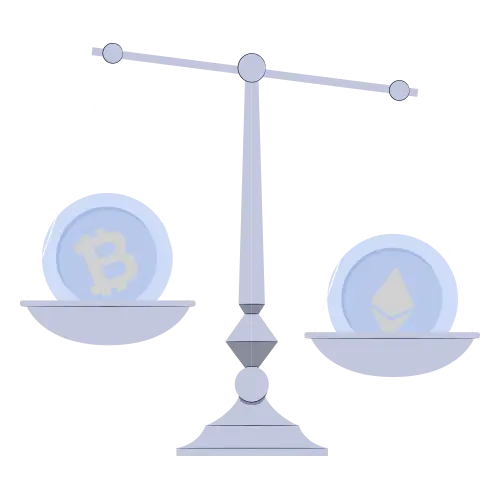Why Is Ethereum Underperforming? Key Factors Behind ETH’s Struggles in 2025

Introduction
Ethereum has been the backbone of the decentralized finance (DeFi) and smart contract ecosystem for years. As the second-largest cryptocurrency by market cap, ETH has historically been seen as a strong investment with long-term potential. However, in recent months, Ethereum has struggled to keep up with competitors like Solana. Why is Ethereum underperforming while other blockchains are gaining traction? Several key factors are holding ETH back, and understanding them can help investors and developers make informed decisions about its future.
What’s Holding Ethereum Back?
1. The Law of Large Numbers
Ethereum’s massive market cap (over $300 billion) makes it harder for ETH to experience the explosive growth that smaller assets enjoy. Simply put, the bigger an asset gets, the more difficult it becomes to sustain rapid gains. Unlike newer blockchains with smaller valuations, Ethereum faces natural market limitations that slow down its growth.
2. Layer 2 Complications & Value Capture Issues
Ethereum has been actively working on Layer 2 scaling solutions (such as Arbitrum and Optimism) to improve transaction speeds and reduce fees. However, these improvements don’t necessarily benefit ETH’s price. Most of the transaction fees and economic activity on Layer 2 networks stay within those networks, reducing the direct impact on Ethereum’s value. In contrast, competitors like Solana operate as a single-layer blockchain, capturing all transaction value within their own ecosystem.
3. Slow Roadmap & Unclear Scaling Future
Ethereum’s scaling roadmap is heavily reliant on upgrades like EIP-4844 (proto-danksharding) and future improvements to Ethereum 2.0. While these solutions promise to make Ethereum faster and more efficient, they are not yet fully implemented. Meanwhile, competitors are already offering high-speed, low-fee transactions, making Ethereum less attractive to new users and developers.
4. Rising Competition from Solana & Other Blockchains
Ethereum is no longer the only game in town. Blockchains like Solana, Avalanche, and Aptos are providing faster transactions, lower fees, and better user experiences—all while attracting top developers. Solana, in particular, has gained significant traction by offering an all-in-one solution that doesn’t require additional layers for scaling. As a result, many projects and investors are shifting away from Ethereum to explore these newer, more efficient alternatives.
Conclusion: Should You Be Worried About Ethereum?
While Ethereum is facing some serious challenges, it is far from dead. ETH still boasts the largest developer community, the deepest DeFi ecosystem, and the strongest institutional trust in the crypto space. If Ethereum can successfully address its scaling issues, improve Layer 2 interoperability, and capture more value from its network, it could regain its competitive edge.
For investors, the key question is: Are you in for the long run, or are you looking for short-term gains? If you believe in Ethereum’s long-term vision, holding ETH may still be a solid strategy. However, if you’re looking for immediate growth and innovation, exploring newer blockchain ecosystems could be a smart move.
🚀 What are your thoughts on Ethereum’s future? Will it bounce back or continue to lag behind its competitors? Let’s discuss!
Rating of this post
Rate
If you enjoyed this article, please rate it.
Ethereum’s struggles stem from a combination of factors, including its massive market cap limiting rapid growth, value capture issues with Layer 2 solutions, a slow scaling roadmap, and rising competition from newer blockchains like Solana, which offer faster transactions and lower fees.
The Law of Large Numbers suggests that as an asset grows, its ability to experience exponential gains diminishes. With a market cap exceeding $300 billion, Ethereum finds it harder to achieve the same high-percentage growth as smaller, emerging blockchains.
Ethereum’s Layer 2 solutions, such as Arbitrum and Optimism, improve transaction speeds and reduce gas fees. However, much of the economic activity generated on Layer 2 networks stays within those ecosystems rather than directly benefiting Ethereum’s price. This contrasts with blockchains like Solana, which capture all transaction value within their native chain.
Ethereum’s future scalability relies on upcoming upgrades like EIP-4844 (proto-danksharding) and Ethereum 2.0. While these improvements aim to enhance efficiency, they are still in development. In the meantime, competitors already offer high-speed, low-cost transactions, making Ethereum less attractive for new projects and users.
Solana, Avalanche, and Aptos provide seamless, low-fee transactions without needing Layer 2 scaling solutions. Solana, in particular, has gained developer and investor interest by offering an all-in-one blockchain with superior speed and affordability. This shift has led to some projects and liquidity migrating away from Ethereum.
Ethereum remains a dominant force in DeFi and smart contracts, with the largest developer community and significant institutional trust. While it faces challenges, successful implementation of scaling solutions and improved Layer 2 interoperability could restore its competitive edge. Investors should evaluate whether they believe in Ethereum’s long-term vision or seek quicker gains in newer blockchain ecosystems.
es, if Ethereum successfully integrates its upcoming upgrades, enhances Layer 2 efficiency, and captures more value from its ecosystem, it could reassert itself as the leading smart contract platform. However, the blockchain industry is evolving rapidly, and Ethereum must continue innovating to stay ahead.
Rating of this post
Rate
If you enjoyed this article, please rate it.







